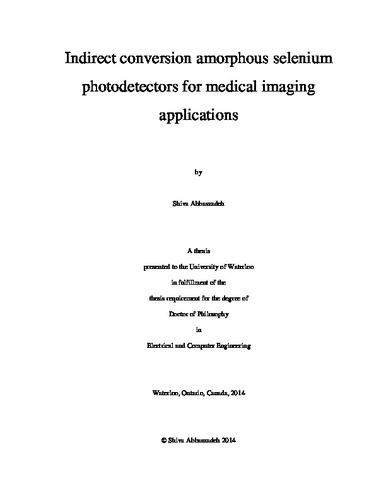| dc.contributor.author | Abbaszadeh, Shiva | |
| dc.date.accessioned | 2014-01-22 19:25:22 (GMT) | |
| dc.date.available | 2014-01-22 19:25:22 (GMT) | |
| dc.date.issued | 2014-01-22 | |
| dc.date.submitted | 2014 | |
| dc.identifier.uri | http://hdl.handle.net/10012/8167 | |
| dc.description.abstract | The innovative design of flat panel volume computed tomography (CT) systems has recently led to the emergence of a wide spectrum of new applications for both diagnostic and interventional purposes, such as ultra-high resolution bone imaging, image guided interventions, dynamic CT angiography, and interventional neuroradiology. Most of these applications require low X-ray dose to limit potential harm to the patient. One of the main challenges of low dose imaging is to maintain a quantum noise limited system to achieve the highest possible signal to noise ratio (SNR) at a given dose. One potential method to achieve a quantum noise limited system is to employ a high gain detector. Current flat panel CT technology is based on indirect conversion detectors that contain a scintillator and hydrogenated amorphous silicon (a-Si:H) p-i-n photodetectors which have a gain below unity and require a specialized p-layer.
In this thesis, an alternative detector to the p-i-n photodetector, which can achieve gain above unity and thus aid in achieving quantum noise limited systems is investigated for large area flat panel imaging. The proposed detector is based on amorphous selenium (a-Se). Amorphous selenium is the most highly developed photoconductor for large area direct conversion X-ray imaging and is still the only commercially available large area direct conversion flat panel X-ray detector. However, the use of a-Se for indirect conversion imaging has not been significantly explored. Amorphous selenium has field dependent mobility and conversion efficiency, which increase with increasing electric field. It is also the only large area compatible avalanche-capable material; a property that was discovered more than 30 years ago. This unique property could be leveraged to provide the gain necessary for low dose medical imaging applications.
The only current commercial avalanche capable a-Se optical detector uses electron beam readout in vacuum, which is not large area compatible and makes integration with pixelated readout electronics challenging. The detector structure proposed in this research seeks to address the challenges associated with integration of an avalanche capable a-Se detector with large area X-ray imager. One important aspect in the development of a-Se avalanche detectors is reducing the dark current and preventing a-Se breakdown as the electric field across the device is increased. A high dark current reduces the dynamic range of the detector, it increases the noise level, and it can lead to crystallization of the detector due to joule heating. To overcome the dark current problem, different blocking layers that allow for integration with large area flat panel imagers were investigated. Experimental results from fabricated devices provided the basis for the choice of the most suitable blocking layer. Two device structures are proposed using the selected blocking layer, a vertical structure and a lateral structure, each having associated benefits and drawbacks. It was shown that introducing a polyimide blocking layer brought down the dark current more than four orders of magnitude at high electric fields and does not deteriorate the charge transport properties of the detectors. The polyimide blocking layer also greatly minimizes physical stress related crystallization in a-Se improving reliability. Gain above unity was observed in the vertical structure and the initiation of impact ionization was verified by performing time-of-flight experiments. Although impact ionization was not verified in the lateral structure, this device structure was found to be highly sensitive to ultraviolet light due to the absence of a top contact layer. Devices were fabricated on several different substrates, including a CMOS substrate, to demonstrate their integration compatibility with large area readout electronics. The exhibited performance of the vertical device structure demonstrates that it is a suitable alternative to the p-i-n photodetector for low dose imaging applications. | en |
| dc.language.iso | en | en |
| dc.publisher | University of Waterloo | en |
| dc.subject | medical imaging | en |
| dc.subject | optoelectronics | en |
| dc.subject | photo-induced effects | en |
| dc.subject | amorphous selenium | en |
| dc.subject | dark current | en |
| dc.subject | avalanche multiplication gain | en |
| dc.subject | large area electronics | en |
| dc.subject | metal-semiconductor-metal device | en |
| dc.subject | X-ray imaging | en |
| dc.subject | positron emission tomography | en |
| dc.subject | flat panel computed tomography | en |
| dc.subject | blocking layer | en |
| dc.subject | UV detection | en |
| dc.title | Indirect conversion amorphous selenium photodetectors for medical imaging applications | en |
| dc.type | Doctoral Thesis | en |
| dc.pending | false | |
| dc.subject.program | Electrical and Computer Engineering | en |
| uws-etd.degree.department | Electrical and Computer Engineering | en |
| uws-etd.degree | Doctor of Philosophy | en |
| uws.typeOfResource | Text | en |
| uws.peerReviewStatus | Unreviewed | en |
| uws.scholarLevel | Graduate | en |

